Shirdi Guide
Shirdi Sai Baba Home Town
Shirdi Map
Shirdi Temple Premises:
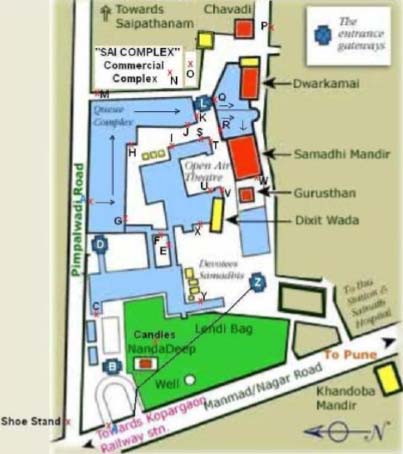
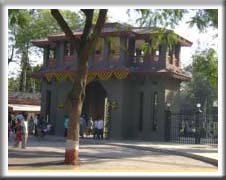
Gate No.1
Gate No.1 is on the West side, on the Nagar-Manmad main road. This
gate is used only as an entry gate into the temple premises and for
Saibaba’s Face Darshan from a distance through a window from near
the raised platform present in the temple premises. Devotees can
freely move around in the temple complex. They can collect Udhi, See
the five Samadhis, Museum and can exit through Gate No.4 towards
Dwarakamai. A devotee cannot go to Lendi Baugh or Baba’s Well. Gate
No.1 is present opposite to the Public Relations Office of the
Sansthan and beside Nanda Deep. There is no option for exit from
this Gate.

Gate No.1
Gate No.1 is on the West side, on the Nagar-Manmad main road. This gate is used only as an entry gate into the temple premises and for Saibaba’s Face Darshan from a distance through a window from near the raised platform present in the temple premises. Devotees can freely move around in the temple complex. They can collect Udhi, See the five Samadhis, Museum and can exit through Gate No.4 towards Dwarakamai. A devotee cannot go to Lendi Baugh or Baba’s Well. Gate No.1 is present opposite to the Public Relations Office of the Sansthan and beside Nanda Deep. There is no option for exit from this Gate.
Gate No.2
Gate No.2 is on the North side on the Pimpalwadi Road and was earlier
used as an Entry and Exit Gate but is closed now and is not in use
any more.
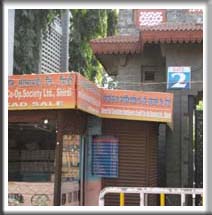
Gate No.2
Gate No.2 is on the North side on the Pimpalwadi Road and was earlier used as an Entry and Exit Gate but is closed now and is not in use any more.

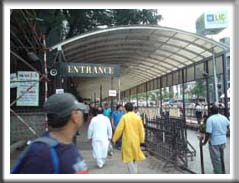
Entry Gate
This Gate is just beside Gate No.2, on the Pimpalwadi Road. This Gate
is the entry gate for all Sai Devotees without any Passes. When a
devotee enters through the Entry Gate, the devotee enters the first
Waiting Hall in the Ground Floor of the “Q” Complex which is
named“Shanti Hall”. After passing through Shanti Hall, the Devotee
enters the second hall named as “Bhakti Hall”. The Shanti Hall and
Bhakti Hall in total have 3 Entry Doors. After the devotee passes
through these 2 Halls, the devotee has to pass through 6 more doors
including the Main Door present in Samadhi Mandir symbolizing
Arishadwarga’s (viz., Kama, Krodha, Loba, Moha , Mada and
Mathsarya). In total the devotee passes through 9 Doors symbolizing
Nava-Vidha Bhakti and reaches Samadhi Mandir. This appropriately
symbolizes the fact that if a devotee enters with Shanti (Peace) and
Bhakti (Devotion) one reaches Mukti (Salvation).

Entry Gate
This Gate is just beside Gate No.2, on the Pimpalwadi Road. This Gate is the entry gate for all Sai Devotees without any Passes. When a devotee enters through the Entry Gate, the devotee enters the first Waiting Hall in the Ground Floor of the “Q” Complex which is named“Shanti Hall”. After passing through Shanti Hall, the Devotee enters the second hall named as “Bhakti Hall”. The Shanti Hall and Bhakti Hall in total have 3 Entry Doors. After the devotee passes through these 2 Halls, the devotee has to pass through 6 more doors including the Main Door present in Samadhi Mandir symbolizing Arishadwarga’s (viz., Kama, Krodha, Loba, Moha , Mada and Mathsarya). In total the devotee passes through 9 Doors symbolizing Nava-Vidha Bhakti and reaches Samadhi Mandir. This appropriately symbolizes the fact that if a devotee enters with Shanti (Peace) and Bhakti (Devotion) one reaches Mukti (Salvation).
Gate No.3
Gate No.3 is on the East side, in the line going inside from the
Pimpalwadi Road. This gate is normally used for Exit out of the
temple premises and leads to Dakshin Mukhi Hanuman Mandir,
Dwarakamai, Chavadi and also Abdul Baba’s Cottage. Devotees can
enter through the left hand side entrance only for "MUKH DARSHAN".
The right hand side entrance is used as a Special Entrance for
Senior Citizens , Physically Challenged Persons and aged devotees,
who are unable to walk. One good thing is that one normal adult is
allowed to accompany and escort any Aged/Handicapped dependent
family member through this gate and a dependent’s kid is also
allowed to, if he/she has no one else to accompany him/her.
Non Resident Indian Devotees and Foreign Nationals are also
sometimes allowed though this Gate when they show proof of
Nationality or NRI Status i.e., Passport/Visa Copies and other
relevant documents.
When a devotee enters through the right hand side of this
Gate he/she can roam in the temple premises except Lendi Baugh and
Baba’s well.
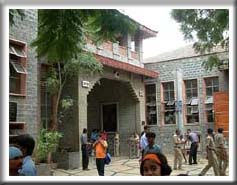
Gate No.3
Gate No.3 is on the East side, in the line going inside from the
Pimpalwadi Road. This gate is normally used for Exit out of the
temple premises and leads to Dakshin Mukhi Hanuman Mandir,
Dwarakamai, Chavadi and also Abdul Baba’s Cottage. Devotees can
enter through the left hand side entrance only for "MUKH DARSHAN".
The right hand side entrance is used as a Special Entrance for
Senior Citizens , Physically Challenged Persons and aged devotees,
who are unable to walk. One good thing is that one normal adult is
allowed to accompany and escort any Aged/Handicapped dependent
family member through this gate and a dependent’s kid is also
allowed to, if he/she has no one else to accompany him/her.
Non Resident Indian Devotees and Foreign Nationals are also
sometimes allowed though this Gate when they show proof of
Nationality or NRI Status i.e., Passport/Visa Copies and other
relevant documents.
When a devotee enters through the right hand side of this
Gate he/she can roam in the temple premises except Lendi Baugh and
Baba’s well.

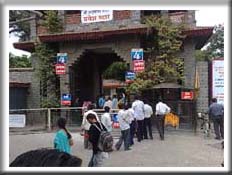
Gate No.4
Gate No.4 is present on the South side and is used mainly for exit
out of the temple premises. The left hand side of this gate leads
the devotee to Dwarakamai while the right hand side of this gate
leads a devotee to Nagar-Manmad main road. Gate No.4 is exactly
opposite to the five Samadhis.
Gate No.4 is also used as an entry with a steel barricaded
passage separating Lendi Baugh and Nanda Deep in such a manner that
if the devotee moves through this entrance, then he will
automatically move towards Lendi Baugh, Baba’s Well and then
straight out of the temple premises to the Nagar-Manmad Main Road.
Hence, if the devotee wants to visit Nanda Deep, then he/she
has to go straight out of the temple premises and then again has to
re-enter through Gate No.1 to visit Nanda Deep.
The Samadhi of Sri Chand Khan Baba (Mote Baba Darga) is
present to the right at the entrance of Gate No.4.

Gate No.4
Gate No.4 is present on the South side and is used mainly for exit
out of the temple premises. The left hand side of this gate leads
the devotee to Dwarakamai while the right hand side of this gate
leads a devotee to Nagar-Manmad main road. Gate No.4 is exactly
opposite to the five Samadhis.
Gate No.4 is also used as an entry with a steel barricaded
passage separating Lendi Baugh and Nanda Deep in such a manner that
if the devotee moves through this entrance, then he will
automatically move towards Lendi Baugh, Baba’s Well and then
straight out of the temple premises to the Nagar-Manmad Main Road.
Hence, if the devotee wants to visit Nanda Deep, then he/she
has to go straight out of the temple premises and then again has to
re-enter through Gate No.1 to visit Nanda Deep.
The Samadhi of Sri Chand Khan Baba (Mote Baba Darga) is
present to the right at the entrance of Gate No.4.
Darshan Waiting Halls:
The darshan waiting halls where devotees line up for visiting Samadhi Mandir are
very spacious and is fully equipped with Water Coolers and adequate Seating
arrangements for the comfort of devotees. In all the waiting halls, television
sets are present at appropriate places to enable the devotees to see what is
happening inside the Santcum Sanctorum while they wait in a queue for longer
periods of time. The halls are also equipped with Refreshment Centres where one
can get Coffee/Tea, Biscuits and Water Bottles. Waiting Halls are also equipped
with Toilet facility.
One can hear Sai Devotees chanting Sai Bhajans / Sai Nama Japa and see them
Reading the Sai Satcharitha /Sai Ashtottara and Sahasranamam while moving
patiently in the queue.
Samadhi Mandir:
If a devotee wants to visit Samadhi Mandir he has to enter through the Gate
which is present just beside Gate No.2 on the Pimpalwadi Road. Samadhi Mandir is
the place where Baba’s Samadhi & Padukas are present.
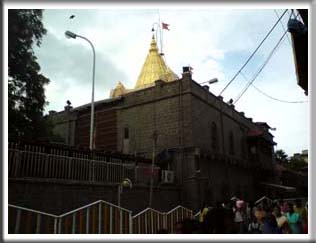
All formal worship of Shri Sai like Mangal Snan (Holy bath), Abhishek and Aarti
are performed in the Samadhi temple only. The temple opens at 4:00 am. But the
devotees form the darshan queue before 4:00 am. The Temple closes at 11:15 pm
after Shej Aarti.
No offerings like garlands, flowers, coconuts, cloth etc. are accepted during Mangal Snan (Holy bath), ceremonial worship
(Shodashopachaar) and aartis (all four aartis).
The first ‘darshan’ of the day, begins after the morning programme of worship
(Morning aarti, Mangal Snan, Shodashopachar). Offerings are accepted only during
'Darshan' hours.
In the Samadhi temple, for standing in the main hall the arrangement of queue
for ladies and gents is separate. This should be particularly borne in mind
while taking along small children.
On the main day of celebration on important occasions like Ram Navami, Dussehra
and Guru Poornima the temple is open throughout the night for darshan. On such
occasions special programmes of devotional songs are organized by the Trust. On
the days when the temple is open throughout the night, the ‘Shej aarti’ (Night
aarti) is not performed and the programme of the following day begins without
the morning aarti (from Mangal Snan onwards). Click here for More
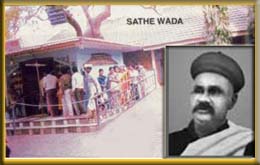
Sathe Wada:
This Wada was just behind the Gurusthan and adjacent to one of the
exit gates of the Samadhi Mandir.
Click here for More

Sathe Wada:
This Wada was just behind the Gurusthan and adjacent to one of the exit gates of the Samadhi Mandir.
Click here for More
Dixit Wada:
This Wada is the double storey building facing south and is adjacent
to Gurusthan.
Click here for More
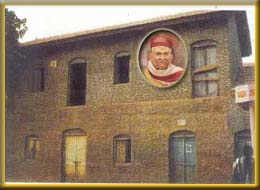
Dixit Wada:
This Wada is the double storey building facing south and is adjacent to Gurusthan.
Click here for More

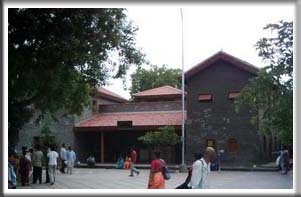
Saibaba Museum
This is just beside Dixit Wada opposite Gurusthan, inside the main
temple complex. The museum houses many items which Saibaba used
during his lifetime. The museum is spread on the ground and first
floor and is very spacious.
The Museum will remain open from 6:00 am to 9:00 pm for
Darshan.
Click here for More

Saibaba Museum
This is just beside Dixit Wada opposite Gurusthan, inside the main
temple complex. The museum houses many items which Saibaba used
during his lifetime. The museum is spread on the ground and first
floor and is very spacious.
The Museum will remain open from 6:00 am to 9:00 pm for
Darshan.
Click here for More
Gurusthan
Gurusthan is at the exit of the main Samadhi Mandir. The old
Gurusthan is modified by Sansthan. It is a practice of many Sai
Devotees to do 108 Pradakshina of the Neem Tree present in Gurusthan
and to light Dhoop on Thursday and Friday evenings after sunset.
There is by and large no restriction on darshan during the day in
Gurusthan, except during a few minutes while attending to the dhuni
or offering food to Shri Sai.
Click here for More
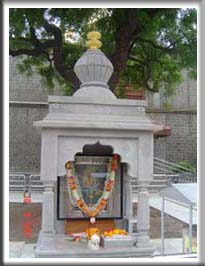
Gurusthan
Gurusthan is at the exit of the main Samadhi Mandir. The old
Gurusthan is modified by Sansthan. It is a practice of many Sai
Devotees to do 108 Pradakshina of the Neem Tree present in Gurusthan
and to light Dhoop on Thursday and Friday evenings after sunset.
There is by and large no restriction on darshan during the day in
Gurusthan, except during a few minutes while attending to the dhuni
or offering food to Shri Sai.
Click here for More

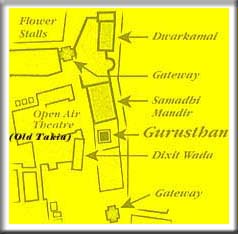
Takia:
Just across from Gurusthan, to the east of Dixit Wada, opposite the
neem tree, near to where an open theatre has recently been built,
there used to be a takia or small shed. A takia is a resting place
for visiting fakirs and Baba also sometimes spent the night here
when he first came to Shirdi.
Click here for More

Takia:
Just across from Gurusthan, to the east of Dixit Wada, opposite the neem tree, near to where an open theatre has recently been built, there used to be a takia or small shed. A takia is a resting place for visiting fakirs and Baba also sometimes spent the night here when he first came to Shirdi.
Click here for More
Parayan Hall
This is on the west side of Lendi Baugh, inside the temple complex.
It is open from 5 am to 8 pm on all days and throughout the night on
festival days like Ramanavami, Gurupurnima and Vijayadashami.
Click here for More
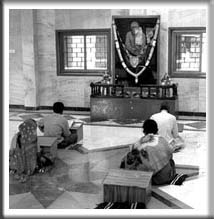
Parayan Hall
This is on the west side of Lendi Baugh, inside the temple complex. It is open from 5 am to 8 pm on all days and throughout the night on festival days like Ramanavami, Gurupurnima and Vijayadashami.
Click here for More

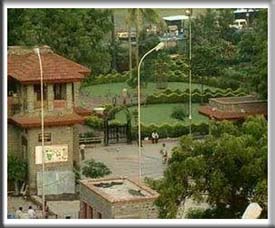
Lendi Baugh (Lendi Gardens)
To see Lendi Baugh a devotee has to enter through Gate No.4 which
takes him/her directly to Lendi Baugh. One can see Datta Mandir,
Ganapati on Peepul Tree, Neem Tree and the Well used by Baba. The
Sansthan has recently made an artificial waterfall inside the Lendi
Gardens.
Click here for More

Lendi Baugh (Lendi Gardens)
To see Lendi Baugh a devotee has to enter through Gate No.4 which takes him/her directly to Lendi Baugh. One can see Datta Mandir, Ganapati on Peepul Tree, Neem Tree and the Well used by Baba. The Sansthan has recently made an artificial waterfall inside the Lendi Gardens.
Click here for More
Nandadeep:
The Nanda Deep is part of the Lendi Baugh but is separated from it
in a manner that If a devotee wants to see Nanda Deep he needs to
enter either through Gate No.1 or Gate No.3 only. It is a practice
by many Sai Devotees to do 108 Pradakshina of Nanda Deep during the
early hours.
There is by and large no restriction on darshan during the day in
Nanda Deep, except during a few minutes while attending to the dhuni
or offering food to Shri Sai.
Click here for More
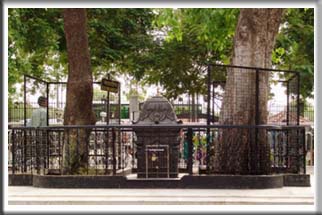
Nandadeep:
The Nanda Deep is part of the Lendi Baugh but is separated from it
in a manner that If a devotee wants to see Nanda Deep he needs to
enter either through Gate No.1 or Gate No.3 only. It is a practice
by many Sai Devotees to do 108 Pradakshina of Nanda Deep during the
early hours.
There is by and large no restriction on darshan during the day in
Nanda Deep, except during a few minutes while attending to the dhuni
or offering food to Shri Sai.
Click here for More

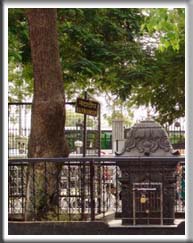
Neem Tree:
This is at the left of the Nanda Deep. This tree was planted by Baba
himself. Baba during his time went daily to Lendi Baugh and spent
two to three hours below this tree.
Click here for More

Neem Tree:
This is at the left of the Nanda Deep. This tree was planted by Baba himself. Baba during his time went daily to Lendi Baugh and spent two to three hours below this tree.
Click here for More
Peepul Tree:
This tree is at the right of the Nanda Deep. Baba during his time
went daily to Lendi Baugh and spent two to three hours below this
tree.
Click here for More
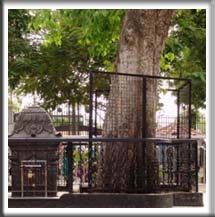
Peepul Tree:
This tree is at the right of the Nanda Deep. Baba during his time went daily to Lendi Baugh and spent two to three hours below this tree.
Click here for More

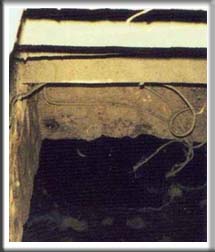
Baba’s Well:
This well is by the side of the Western Compound Wall of Lendi Baugh.
Click here for More

Baba’s Well:
This well is by the side of the Western Compound Wall of Lendi Baugh.
Click here for More
Dattatreya Mandir:
It is at the front of the Nanda Deep, a little distance away.
Click here for More
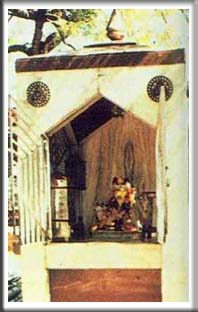
Dattatreya Mandir:
It is at the front of the Nanda Deep, a little distance away.
Click here for More

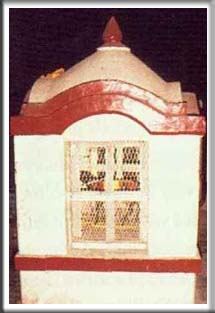
Samadhi of Shyam Karan:
The Samadhi of Shyam Karan is next to the Dattatreya Mandir inside Lendi Baugh.
Click here for More

Samadhi of Shyam Karan:
The Samadhi of Shyam Karan is next to the Dattatreya Mandir inside Lendi Baugh.
Click here for More
Samadhi of Amidas Bhavani Mehta:
The Samadhi of Amidas Bhavani Mehta, a Gujarati Sai Devotee who wrote and published many stories on Saibaba is next to the Samadhi of Shyam Karan.
Click here for More
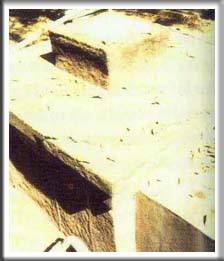
Samadhi of Amidas Bhavani Mehta:
The Samadhi of Amidas Bhavani Mehta, a Gujarati Sai Devotee who wrote and published many stories on Saibaba is next to the Samadhi of Shyam Karan.
Click here for More

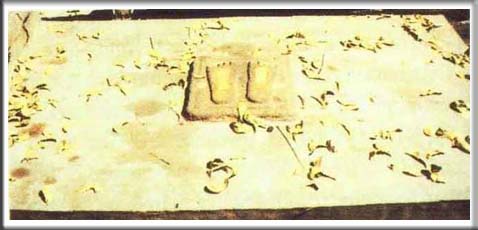
Samadhi of Muktharam (Khandesh):
This Samadhi of Muktharam is to the left of the Samadhi of Amidas Bhavani Mehta.
Click here for More

Samadhi of Muktharam (Khandesh):
This Samadhi of Muktharam is to the left of the Samadhi of Amidas Bhavani Mehta.
Click here for More
Three Temples (Ganpati, Shani and Mahadev):
The three temples dedicated to Ganapati, Shani and Mahadev are just behind the new outdoor theatre, inside the temple complex.
Click here for More
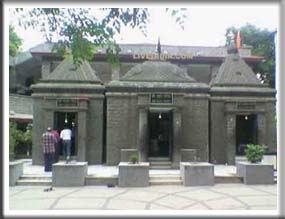
Three Temples (Ganpati, Shani and Mahadev):
The three temples dedicated to Ganapati, Shani and Mahadev are just behind the new outdoor theatre, inside the temple complex.
Click here for More

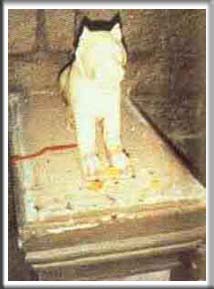
Tiger’s Samadhi:
The Samadhi of Tiger is present just opposite to Mahadev Temple.
Click here for More

Tiger’s Samadhi:
The Samadhi of Tiger is present just opposite to Mahadev Temple.
Click here for More
Five Samadhis:
The five Samadhi’s of Abdul Baba, Nanavalli, V.P.Iyer, Bhau Maharaj Kumbara and Tatya Kote Patil are beside Lendi Baugh, opposite to Udhi Distribution Centre, inside the temple complex.
Click here for More
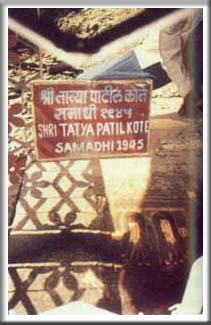
Five Samadhis:
The five Samadhi’s of Abdul Baba, Nanavalli, V.P.Iyer, Bhau Maharaj Kumbara and Tatya Kote Patil are beside Lendi Baugh, opposite to Udhi Distribution Centre, inside the temple complex.
Click here for More

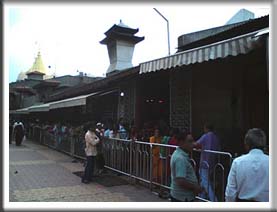
Dwarakamai:
This is the place where Saibaba lived for almost 60 years and is very sacred from the point of view of Sai Devotees. This is next to Saibaba’s Chavadi. Dwarakamai is at the right side of Gate No.3 (exit) or to the Left of Gate No.4 (exit).
There is by and large no restriction on darshan during the day in Dwarkamai masjid, except during a few minutes while attending to the dhuni or offering food to Shri Sai.
Click here for More

Dwarakamai:
This is the place where Saibaba lived for almost 60 years and is very sacred from the point of view of Sai Devotees. This is next to Saibaba’s Chavadi. Dwarakamai is at the right side of Gate No.3 (exit) or to the Left of Gate No.4 (exit).
There is by and large no restriction on darshan during the day in Dwarkamai masjid, except during a few minutes while attending to the dhuni or offering food to Shri Sai.
Click here for More
Saibaba Chavadi:
Saibaba’s Chavadi is opposite Abdul Baba’s Cottage. The Chavadi has been divided into 2 parts. The left portion is “for Ladies” only, while the right hand side is “only for Gents” where no ladies are allowed in the place where Baba used to sleep from the beginning.
There is by and large no restriction on darshan during the day in Chavadi, except during a few minutes while attending to the dhuni or offering food to Shri Sai.
The Chavadi will remain open daily from 4:30 am to 9:00 pm for darshan.
Click here for More
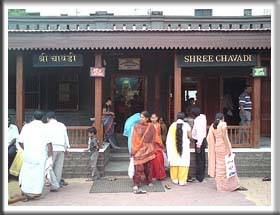
Saibaba Chavadi:
Saibaba’s Chavadi is opposite Abdul Baba’s Cottage. The Chavadi has been divided into 2 parts. The left portion is “for Ladies” only, while the right hand side is “only for Gents” where no ladies are allowed in the place where Baba used to sleep from the beginning.
There is by and large no restriction on darshan during the day in Chavadi, except during a few minutes while attending to the dhuni or offering food to Shri Sai.
The Chavadi will remain open daily from 4:30 am to 9:00 pm for darshan.
Click here for More

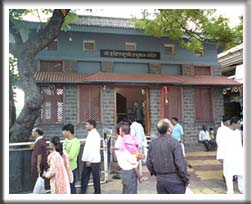
Dakshin Mukhi Hanuman Temple:
The Saibaba Sansthan has demolished the old temple and a new temple has come up in its place. This temple is just a few yards from Gate No.3. A life size blackstone Idol of Hanuman and a small Idol of Hanuman are present in the temple.
Click here for More

Dakshin Mukhi Hanuman Temple:
The Saibaba Sansthan has demolished the old temple and a new temple has come up in its place. This temple is just a few yards from Gate No.3. A life size blackstone Idol of Hanuman and a small Idol of Hanuman are present in the temple.
Click here for More
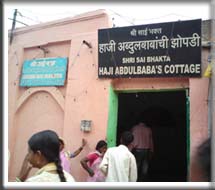
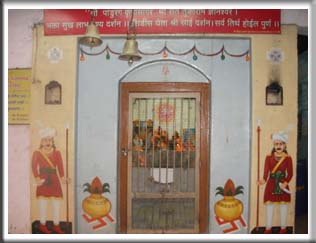
Mahalakshmi Mandir:
This temple is on the Pimpalwadi main road, adjacent to Pilgrims Inn.
Click here for More
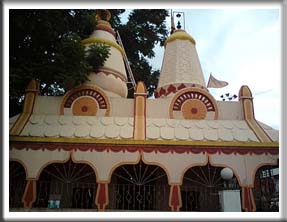
Mahalakshmi Mandir:
This temple is on the Pimpalwadi main road, adjacent to Pilgrims Inn.
Click here for More

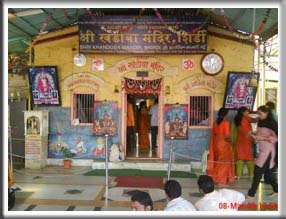
Khandoba Mandir:
After arriving in shirdi, one must visit Shri Khandoba Mandir before having darshan of Saibaba. Khandoba, an Avatar of Shiva, is the Kul Devata of Maharashtra. The mandir is located adjacent to Shri Sainath Hospital, opposite to Bus Stand. Mahalsapathi was the priest of this temple. The significance of visiting Khandoba Mandir first, is as follows:
Baba came along with Chand Patil’s marriage party and placed his foot under a banyan tree. The priest at the temple, Mahalsapathi welcomed Baba by saying “Aao Sai”. The fakir without a name began to be called “Sai Baba” from then onwards by the villagers of Shirdi.
Click here for More

Khandoba Mandir:
After arriving in shirdi, one must visit Shri Khandoba Mandir before having darshan of Saibaba. Khandoba, an Avatar of Shiva, is the Kul Devata of Maharashtra. The mandir is located adjacent to Shri Sainath Hospital, opposite to Bus Stand. Mahalsapathi was the priest of this temple. The significance of visiting Khandoba Mandir first, is as follows:
Baba came along with Chand Patil’s marriage party and placed his foot under a banyan tree. The priest at the temple, Mahalsapathi welcomed Baba by saying “Aao Sai”. The fakir without a name began to be called “Sai Baba” from then onwards by the villagers of Shirdi.
Click here for More
Banyan Tree:
This is the blessed Banyan Tree that gave shade to the marriage party of Chand Patil and family. This tree is in front of the Khandoba Mandir.
Click here for More
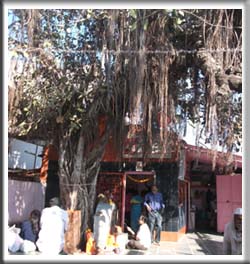
Banyan Tree:
This is the blessed Banyan Tree that gave shade to the marriage party of Chand Patil and family. This tree is in front of the Khandoba Mandir.
Click here for More

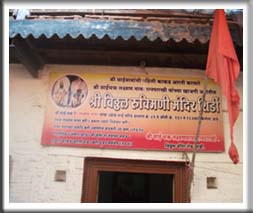
Vittal Mandir:
This Mandir is situated on the left side of the street leading to old Post Office.
Click here for More

Vittal Mandir:
This Mandir is situated on the left side of the street leading to old Post Office.
Click here for More
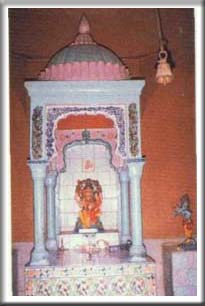
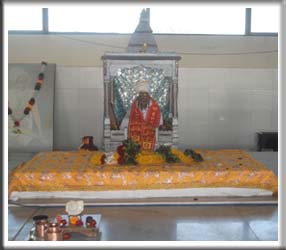
Shivaneshan Swamiji’s Samadhi:
The Samadhi of this Great Sai Devotee is on the Pimpalwadi Main Road.
Click here for More

Shivaneshan Swamiji’s Samadhi:
The Samadhi of this Great Sai Devotee is on the Pimpalwadi Main Road.
Click here for More
Tapobhumi Mandir:
This is situated on the Banks of the Godavari River, on the way to Kopergaon Railway Station.
Click here for More
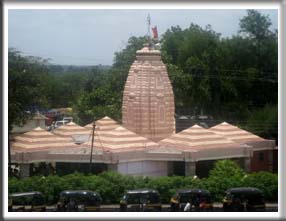
Tapobhumi Mandir:
This is situated on the Banks of the Godavari River, on the way to Kopergaon Railway Station.
Click here for More

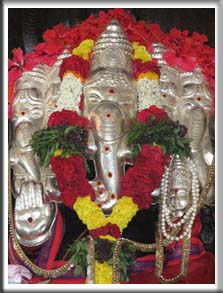
Panchamukhi Vinayak Temple:
This temple is situated just 2 KM from Shirdi Saibaba Sansthan.
Click here for More

Panchamukhi Vinayak Temple:
This temple is situated just 2 KM from Shirdi Saibaba Sansthan.
Click here for More
Shri Sai Dham Mandir:
Saidham popularly known as Sai Mandir is situated off Kopargaon - Manmad highway. It is about 1 KM from Kopargaon Railway Station. This Temple was started on 16th June 1999 by Late Shri.Dhondiram Baba Chavan. There is Gurusthan at the temple entrance with a miraculous Neem Tree at the Entry gate. Sai Devotees tie the Sacred Thread on Thursdays to this miraculous Neem Tree for getting their desires fulfilled. There is original Photograph of Saibaba at Gurusthan where Devotees have experienced the presence of Saibaba himself. There is also Shivaling and Nandi at Gurusthan.
Click here for More
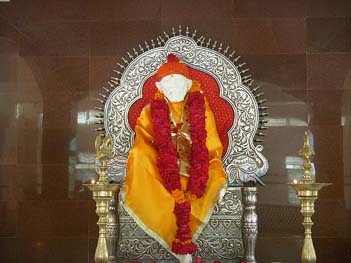
Shri Sai Dham Mandir:
Saidham popularly known as Sai Mandir is situated off Kopargaon - Manmad highway. It is about 1 KM from Kopargaon Railway Station. This Temple was started on 16th June 1999 by Late Shri.Dhondiram Baba Chavan. There is Gurusthan at the temple entrance with a miraculous Neem Tree at the Entry gate. Sai Devotees tie the Sacred Thread on Thursdays to this miraculous Neem Tree for getting their desires fulfilled. There is original Photograph of Saibaba at Gurusthan where Devotees have experienced the presence of Saibaba himself. There is also Shivaling and Nandi at Gurusthan.
Click here for More

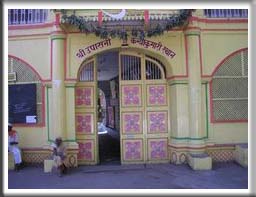
Sakori Ashram:
This Ashram of Upasni Maharaj is situated at a distance of just 5 Kilometers from Shirdi.
Click here for More

Sakori Ashram:
This Ashram of Upasni Maharaj is situated at a distance of just 5 Kilometers from Shirdi.
Click here for More
Samadhi of Bapu Saheb Jog:
After the demise of Megha, Bapu Saheb Jog was performing Saibaba's Aarti till Baba's Samadhi. The final Aarti to Saibaba was performed by Bapu Saheb Jog. His Samadhi is at Sakori Village near Upasini Baba's Ashram about 5 kilometers from Shirdi.
Click here for More
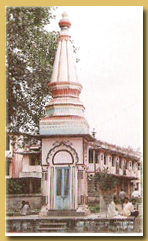
Samadhi of Bapu Saheb Jog:
After the demise of Megha, Bapu Saheb Jog was performing Saibaba's Aarti till Baba's Samadhi. The final Aarti to Saibaba was performed by Bapu Saheb Jog. His Samadhi is at Sakori Village near Upasini Baba's Ashram about 5 kilometers from Shirdi.
Click here for More

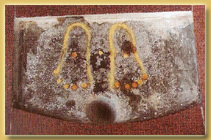
Saibaba Temple Kohrale:
This temple is about 10 kilometers from Shirdi. Saibaba's Padukas which was in front of Narasimha Lodge in the wall were removed from that place when Shirdi Saibaba Sansthan were widening the “Palki Road”. The same Padukas are installed in Kohrale Temple on the auspicious day of Gurupoornima in the year 2004.
Click here for More

Saibaba Temple Kohrale:
This temple is about 10 kilometers from Shirdi. Saibaba's Padukas which was in front of Narasimha Lodge in the wall were removed from that place when Shirdi Saibaba Sansthan were widening the “Palki Road”. The same Padukas are installed in Kohrale Temple on the auspicious day of Gurupoornima in the year 2004.
Click here for More
Sri Shirdi Saibaba Padukasthan:
Nimon Village is just 40 KMS from Shirdi. In this place, the holy Padukas given by Shirdi Saibaba to Sri.Shankar Rao Raghunath Deshpande Alias Nana Saheb Nimonkar in the year 1898 is present.
Click here for More
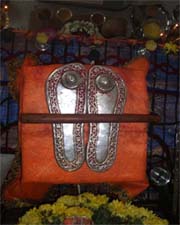
Sri Shirdi Saibaba Padukasthan:
Nimon Village is just 40 KMS from Shirdi. In this place, the holy Padukas given by Shirdi Saibaba to Sri.Shankar Rao Raghunath Deshpande Alias Nana Saheb Nimonkar in the year 1898 is present.
Click here for More

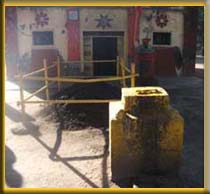
Neemgoan
This is a place that Baba visited frequently during his sojourn in Shirdi. Baba used to visit Nana Saheb Dengle’s House, Khandoba Mandir and the Holy Well near Khandoba Mandir.
Click here for More

Neemgoan
This is a place that Baba visited frequently during his sojourn in Shirdi. Baba used to visit Nana Saheb Dengle’s House, Khandoba Mandir and the Holy Well near Khandoba Mandir.
Click here for More
Ruigaon
Saibaba occasionally went to Ruigaon which is on the opposite side of Neemgaon. There is an ancient “Audumbar Tree” which dates back to few years before Saibaba’s arrival in Shirdi. Below the Audumbar Tree Black Stone “Shivalinga” and “Nandi” are installed. In front of the Audumbar Tree there is a “Sankat Mochan Hanuman Mandir”. Below the Audumbar Tree on the backside of Shivalinga there is an “Ek Mukhi Dattatreya Mandir”. Besides the Sankat Mochan Hanuman Mandir there is a temple dedicated to “Saptashrungi Mata”.
Click here for More
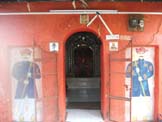
Ruigaon
Saibaba occasionally went to Ruigaon which is on the opposite side of Neemgaon. There is an ancient “Audumbar Tree” which dates back to few years before Saibaba’s arrival in Shirdi. Below the Audumbar Tree Black Stone “Shivalinga” and “Nandi” are installed. In front of the Audumbar Tree there is a “Sankat Mochan Hanuman Mandir”. Below the Audumbar Tree on the backside of Shivalinga there is an “Ek Mukhi Dattatreya Mandir”. Besides the Sankat Mochan Hanuman Mandir there is a temple dedicated to “Saptashrungi Mata”.
Click here for More

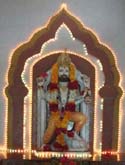
Viroba Ban Kanch Mandir:
This famous temple dedicated Lord Veerabhadra (Viroba) is situated at Ban Village on the Ban Road in Rahata Taluk of Ahmed Nagar District of Maharashtra. The temple is present at a distance of about 5 Kilometers from Shirdi Saibaba Samadhi Mandir (Refer Shri Sai Satcharitra, Chapter 47).
Click here for More

Viroba Ban Kanch Mandir:
This famous temple dedicated Lord Veerabhadra (Viroba) is situated at Ban Village on the Ban Road in Rahata Taluk of Ahmed Nagar District of Maharashtra. The temple is present at a distance of about 5 Kilometers from Shirdi Saibaba Samadhi Mandir (Refer Shri Sai Satcharitra, Chapter 47).
Click here for More
Jangli Maharaj Ashram:
This Ashram is about seven kilometers from Shirdi on Shirdi-Kopargaon state highway No – 10. Vishwatmak Jangli Maharaj Ashram Trust was established under guidance & blessings of "His Holiness Param Pujya Vishwatmak Gurudev”.
Click here for More

Jangli Maharaj Ashram:
This Ashram is about seven kilometers from Shirdi on Shirdi-Kopargaon state highway No – 10. Vishwatmak Jangli Maharaj Ashram Trust was established under guidance & blessings of "His Holiness Param Pujya Vishwatmak Gurudev”.
Click here for More


Sant Janardan Swami Ashram:
Nishkama Karmayogi Saint Param Poojya Shri.Janardan Swami (Moungiri) Maharaj is a Maharshi belonging to the traditionally illustrious great saints of our century. Swamiji throughout his life carried out with great devotion, the great task of awakening and liberating the common people from their narrow, routine, materialistic outlook in life.
Click here for More

Sant Janardan Swami Ashram:
Nishkama Karmayogi Saint Param Poojya Shri.Janardan Swami (Moungiri) Maharaj is a Maharshi belonging to the traditionally illustrious great saints of our century. Swamiji throughout his life carried out with great devotion, the great task of awakening and liberating the common people from their narrow, routine, materialistic outlook in life.
Click here for More
Guru Shukracharya Mandir
This unique temple dedicated to Lord Shukracharya is at a distance of 15 Kilometers from Shirdi on Ahmed Nagar Manmad Highway. This is the first of its kind temple in the entire world and is more than 400 years old.
Click here for More

Guru Shukracharya Mandir
This unique temple dedicated to Lord Shukracharya is at a distance of 15 Kilometers from Shirdi on Ahmed Nagar Manmad Highway. This is the first of its kind temple in the entire world and is more than 400 years old.
Click here for More

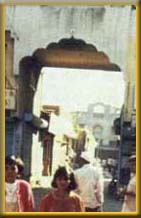
Rahata:
This is a place that Baba visited frequently during his sojourn in Shirdi. Baba used to visit Kushal Chand’s House, the Idgah and Maruti Mandir.
Click here for More

Rahata:
This is a place that Baba visited frequently during his sojourn in Shirdi. Baba used to visit Kushal Chand’s House, the Idgah and Maruti Mandir.
Click here for More
Sadguru Chotebaba Mandir
Sadguru Chotebaba Mandir is in Khandoba Temple premises. In this Mandir, Life size photograph of Saint Chotebaba and Sacred Dhuni are present.
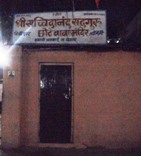
Sadguru Chotebaba Mandir
Sadguru Chotebaba Mandir is in Khandoba Temple premises. In this Mandir, Life size photograph of Saint Chotebaba and Sacred Dhuni are present.

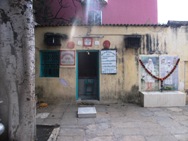
Homi Baba Ashram
The Ashram of famous Parsi Saint Homi Baba in present on Pimplwadi Road next to Gobind Dham. Homi Baba came to Shirdi in the year 1918, the Maha Samadhi year of Shirdi Saibaba. He attained Samadhi in the year 1995. During his sojourn he influenced many people especially Parsi Community People to become Sai Devotees.
Ashram Contact Details:
Homi Baba Ashram
Pimpalwadi Road, Next to Gobind Dham,
Shirdi-423 109,
Contact Persons:Sri.Avathade/Sri.Ayub Gulzar Pathan
Contact Numbers: +91 98223 43558 / +91 98504 49728

Homi Baba Ashram
The Ashram of famous Parsi Saint Homi Baba in present on Pimplwadi Road next to Gobind Dham. Homi Baba came to Shirdi in the year 1918, the Maha Samadhi year of Shirdi Saibaba. He attained Samadhi in the year 1995. During his sojourn he influenced many people especially Parsi Community People to become Sai Devotees.
Ashram Contact Details:
Homi Baba Ashram
Pimpalwadi Road, Next to Gobind Dham,
Shirdi-423 109,
Contact Persons:Sri.Avathade/Sri.Ayub Gulzar Pathan
Contact Numbers: +91 98223 43558 / +91 98504 49728
Shri Saibaba Prasadalaya:
The Prasadalaya which was situated next to Samadhi Mandir has been shifted permanently to a new building constructed by the Sansthan on 8th January 2009.
The address of Prasadalaya is as below:
Shri Saibaba Prasadalaya
Behind Police Station,
Nimgaon Shiv Road,
Nimgaon Korhale,
Shirdi.
Shri Shirdi Saibaba Sansthan is running free Bus Services from Gate No.2 opposite Old Prasadalaya, where the Laddu Counter is situated now from 9:30 am to 9:00 pm.
The Sansthan is providing very high quality meals at a subsidized price of Rs.10/-. The Sansthan has made provision for monthly pass fecility.
Click here for More
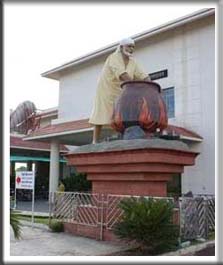
Shri Saibaba Prasadalaya:
The Prasadalaya which was situated next to Samadhi Mandir has been shifted permanently to a new building constructed by the Sansthan on 8th January 2009.
The address of Prasadalaya is as below:
Shri Saibaba Prasadalaya
Behind Police Station,
Nimgaon Shiv Road,
Nimgaon Korhale,
Shirdi.
Shri Shirdi Saibaba Sansthan is running free Bus Services from Gate No.2 opposite Old Prasadalaya, where the Laddu Counter is situated now from 9:30 am to 9:00 pm.
The Sansthan is providing very high quality meals at a subsidized price of Rs.10/-. The Sansthan has made provision for monthly pass fecility.
Click here for More

